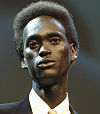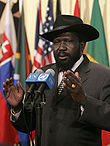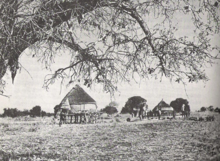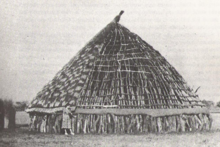- Dinka people
-
This article is about the ethnic group. For the language, see Dinka language. For the Hungarian wine grape, see Dinka (grape).
Dinka 



Total population More than 1.5 million Regions with significant populations  South Sudan
South SudanLanguages Religion Majority of 75% practice Christianity
Related ethnic groups The Dinka is an ethnic group inhabiting the Bahr el Ghazal region of the Nile basin, Jonglei and parts of southern Kordufan and Upper Nile regions. They are mainly agro-pastoral people, relying on cattle herding at riverside camps in the dry season and growing millet (Awuou) and other varieties of grains (rap) in fixed settlements during the rainy season. They number around 1.5 million people, constituting about 10% of the population [1] of the entire country, and constitute the largest ethnic tribe in South Sudan. Dinka, or as they refer to themselves, Muonyjang (singular) and jieng (plural), are one of the branches of the River Lake Nilotes (mainly sedentary agri-pastoral peoples of East Africa who speak Nilotic languages, including the Nuer and Luo).[2] Dinka are sometimes noted for their height. With the Tutsi of Rwanda, they are believed to be the tallest people in Africa.[3] Roberts and Bainbridge reported average height of 182.6 cm (5 ft 11.9 in) in a sample of 52 Dinka Ageir and 181.3 cm (5 ft 11.4 in) in 227 Dinka Ruweng measured in 1953–1954.[4] However, it seems that stature of today's Dinka males is lower, possibly as a consequence of undernutrition and war conflicts. An anthropometric survey of Dinka men-war refugees in Ethiopia published in 1995 found a mean height of 176.4 cm (5 ft 9.4 in) in the Ethiopian Medical Journal.[5]
The Dinka have no centralised political authority, instead comprising many independent but interlinked clans. Certain of those clans traditionally provide ritual chiefs, known as the "masters of the fishing spear" or "beny bith",[6] who provide leadership for the entire people and appear to be at least in part hereditary.
Their language called Dinka as well as "thuɔŋjäŋ (thuongjang)" is one of the Nilotic languages of the Eastern Sudanic language family. The name means "people" in the Dinka language. It is written using the Latin alphabet with a few additions.
Contents
Pastoral strategies
- Southern Sudan has been described as “a large basin gently sloping northward (Roth 2003),” through which flow the Bahr el Jebel River, the (White Nile), the Bahr el Ghazal (Nam) River and its tributaries, and the Sobat, all merging into a vast barrier swamp.
- Vast Sudanese oil areas to the south and east are part of the flood plain, a basin in the southern Sudan into which the rivers of Congo, Uganda, Kenya, and Ethiopia drain off from an ironstone plateau that belts the regions of Bahr El Ghazal and Upper Nile.
- The terrain can be divided into four land classes:
- Highlands—higher than the surrounding plains by only a few centimeters; are the sites for “permanent settlements.” Vegetation consists of open thorn woodland and/or open mixed woodland with grasses.
- Intermediate Lands—lie slightly below the highlands, commonly subject to flooding from heavy rainfall in the Ethiopian and East/Central African highlands; Vegetation is mostly open perennial grassland with some acacia woodland and other sparsely distributed trees.
- Toic—land seasonally inundated or saturated by the main rivers and inland water-courses, retaining enough moisture throughout the dry season to support cattle grazing.
- Sudd—permanent swampland below the level of the toic; covers a substantial part of the floodplain in which the Dinka reside; provides good fishing but is not available for livestock; historically it has been a physical barrier to outsiders’ penetration.
- Ecology of large basin is unique; until recently, wild animals and birds flourished, hunted rarely by the agro-pastoralists (Roth 2003).
The Dinka tribe (or Jieng) has ten subdivisions: Gok Arol, Atuot, Aliab, Bor, Chiej, Agar, Gok, Rek, Twic/Tuic East,[7][8][9] Malual, and Ngok. Malual is the largest of those groups, numbering over a million people. The Dinka's migrations are determined by the local climate, their agro-pastoral lifestyle responding to the periodic flooding and dryness of the area in which they live. They begin moving around May–June at the onset of the rainy season to their “permanent settlements” of mud and thatch housing above flood level, where they plant their crops of millet and other grain products.
These rainy season settlements usually contain other permanent structures such as cattle byres (luaak) and granaries. During dry season (beginning about December–January), everyone except the aged, ill, and nursing mothers migrate to semi-permanent dwellings in the toic for cattle grazing. The cultivation of sorghum, millet, and other crops begins in the highlands in the early rainy season and the harvest of crops begins when the rains are heavy in June–August. Cattle are driven to the toic in September and November when the rainfall drops off; allowed to graze on harvested stalks of the crops.[10]
Cultural and religious beliefs
The Dinkas' pastoral lifestyle is also reflected in their religious beliefs and practices. They have one God, Nhialic, who speaks through spirits that take temporary possession of individuals in order to speak through them. The sacrificing of oxen by the "masters of the fishing spear" is a central component of Dinka religious practice. Age is an important factor in Dinka culture, with young men being inducted into adulthood through an initiation ordeal which includes marking the forehead with a sharp object. Also during this ceremony they acquire a second cow-colour name. The Dinka derive religious power from nature and the world around them, rather than from a religious tome.[11]
Following the war, Christianity predominated over Dinka religious practices, being introduced to the region by British missionaries in the 19th century and during the civil war.
War with the North and status as refugees
The Dinka's religions, beliefs and lifestyle have led to conflict with the government in Khartoum. The Sudan People's Liberation Army, led by late Dr. John Garang De Mabior, a Dinka, took arms against the government in 1983. During the subsequent 21-year civil war, many thousands of Dinka, along with fellow non-Dinka southerners, were massacred by government forces. The Dinka have also engaged in a separate civil war with the Nuer.
Sizable groups of Dinka refugees may be found in distant lands, including Jacksonville, Florida and Clarkston, a working-class suburb of Atlanta, Georgia and in the Midwest such as Omaha NE, Des Moines IA, Sioux Falls SD, and Kansas MO, as well as Edmonton in Canada.
The experience of Dinka refugees was portrayed in the documentary movies Lost Boys of Sudan by Megan Mylan and Jon Shenk and God Grew Tired Of Us, Joan Hechts' book The Journey of the Lost Boys and the fictionalized autobiography of a Dinka refugee, Dave Eggers' What Is the What: The Autobiography of Valentino Achak Deng. Other books on and by the Lost Boys include The Lost Boys of Sudan by Mark Bixler, God Grew Tired of Us by John Bul Dau, and They Poured Fire On Us From The Sky by Alephonsion Deng, Benson Deng, and Benjamin Ajak. In 2004 the first volume of the graphic novel 'Echoes of the Lost Boys of Sudan'[12] was released in Dallas, Texas, United States, chronicling in art and dialogue four lost boys' escapes from the destruction of their hometowns in South Sudan. The Florida ska punk group, Against All Authority refers to the Dinka clan in the song "Dinkas When I Close My Eyes" from their album 24 Hour Roadside Resistance.
1991 Bor Massacre
On November 15, 1991 the event known as the "Bor Massacre" or Southwestern Dinka Massacre commenced in South Sudan. Forces led by the breakaway faction of Riek Machar deliberately killed an estimated 2,000 civilians in Bor and wounded several thousand more over the course of two months. It is estimated a 100,000 people left the area following the attack.[13] Famine followed the massacre, as Machar's forces had looted and burnt villages and as well as raiding cattle. An estimated 25,000 more people died as a result of hunger, according to Amnesty International.
The Bor massacre was triggered by a coup declaration against the then SPLM chairman, the late Dr. John Garang on August 28, 1991, by the current vice president of the government of South Sudan, Dr. Riek Machar. His motives are believed to be an attempt to hurt the Dinka, and to create a pluralistic less Dinka centric model for the SPLM. Thousands of civilians in the Bor area died when Dr. Riek's Nuer forces turned against them and killed them after his failure to topple Dr. John Garang. Some people had perished in the Bor areas as determined by the United Nations assessment of casualties in 1992.
Dr. Riek described the incident as "propaganda" and "myth" despite evidence of mass killing shown by bones and corpses in the aftermath of the massacre.
Notable Dinka
Among well-known Dinka are:
- Abel Alier, known as Wal Kwai the first southerner to be become Vice President of Sudan in 1972
- John Garang, Former First Vice-President of Sudan and President of South Sudan, Commander in Chief of Sudan People's Liberation Army and Chairman of Sudan People's Liberation Movement.
- Lt. General Dominic Dim Deng, South Sudan's first political officer of SPLA, Minister for SPLA Affairs.
- Lt. General Salva Kiir Mayardit, Dr. Garang's successor as First Vice-President of Sudan and President of South Sudan, Commander in Chief of Sudan People's Liberation Army and Chairman of Sudan People's Liberation Movement.
- Alek Wek, a notable fashion model.
- Manute Bol, Former NBA player. One of the two tallest players in the league's history.
- Luol Deng, current NBA player.
- Ater Majok, former NBA player.
- Francis Deng, author, SAIS Research Professor.
- Valentino Achak Deng, a former Lost Boy and subject of What Is the What: The Autobiography of Valentino Achak Deng, a biographical novel written by Dave Eggers.
- John Bul Dau, one of the "Lost Boys of Sudan", author of God Grew Tired of Us, his autobiography, and subject of the documentary of the same title.
- Majak Daw, the first Sudanese Australian to be drafted by a senior Australian Football League club. Daw selected with pick 9 in the rookie draft by the North Melbourne Football Club on December 15, 2009. Daw's achievement is all the more notable given he has only been playing the game for four years.[14]
References
- ^ Ancient Historical Society Virtual Museum, 2010
- ^ Seligman, C. G.; Seligman, Brenda Z. (1965). Pagan Tribes of the Nilotic Sudan. London: Routledge & Kegan Paul.
- ^ "The Tutsi". In and Out of Focus: Images from Central Africa 1885-1960. National Museum of African Art, Smithsonian Institution. http://www.nmafa.si.edu/exhibits/focus/tutsi.html.
- ^ Roberts, D. F.; Bainbridge, D. R. (1963). "Nilotic physique". Am J Phys Anthropol 21 (3): 341–370. doi:10.1002/ajpa.1330210309.
- ^ Chali, D. (1995). "Anthropometric measurements of the Nilotic tribes in a refugee camp". Ethiopian Medical Journal 33 (4): 211–217. PMID 8674486.
- ^ Lienhardt, G. (1961). Divinity and Experience: the Religion of the Dinka. Oxford: Clarendon Press.
- ^ "TECOSS". Twic East Community of South Sudan. http://www.twiceast.org.
- ^ "Sudanese Twic Association of Michigan". http://www.twicom.org.
- ^ "The UN Refugee Agency". UNHCR. http://www.unhcr.org.
- ^ Deng, Francis Mading. The Dinka of the Sudan. Prospect Heights: Waveland Press, Inc., 1972.
- ^ Beswick, S.F. (1994) JAAS XXIX, 3-4 (c) E. J. Brill, Leiden Religious Beliefs
- ^ Cuellar, Catherine (June 28, 2004). "'Echoes of the Lost Boys of Sudan': Comic Book Tells Harrowing Tale of Refugee Children". NPR News. NPR. http://www.npr.org/templates/story/story.php?storyId=3022317.
- ^ Clammer, Paul (2005). Sudan: Bradt Travel Guide. Bradt Travel Guides. http://books.google.co.uk/books?id=lvVao2vWnxUC&pg=PA229&lpg=PA229&dq=1991+Bor+Massacre&source=bl&ots=Lpst3pEOhT&sig=J_lseLZofosvzAjYEsqj3XYfzUE&hl=en&ei=JThjTYS6E8Wl8QP1lJDyCA&sa=X&oi=book_result&ct=result&resnum=8&ved=0CD4Q6AEwBzgU#v=onepage&q=1991%20Bor%20Massacre&f=false. Retrieved 22 March 2011.
- ^ Lavell, Steve (15 December 2009). "A touch of Majak". North Melbourne Football Club. http://www.kangaroos.com.au/season2008/news/newsarticle/tabid/4912/newsid/88198/default.aspx. Retrieved 28 February 2010.
why Kerubino is not there in notable people list?
Further reading
- Garang de Mabior, John (June, 2011). The Undiscovered Stories About Man Behind South Sudanese' Freedom. ISBN 978-0-9837134-1-8.
- Stubbs, J.M.; Morison C.G.T. (1940). The Western Dinkas, Their land and their agriculture. Sudan Notes and Records XXI. pp. 251–266.
- "Dinka (Thuɔŋjäŋ)". Open Road. Vicnet, a division of the State Library of Victoria. http://www.openroad.net.au/languages/african/dinka-2.html.
Categories:- Ethnic groups in Sudan
- Ethnic groups in South Sudan
- Pastoralists
- Nilotic peoples
- Indigenous peoples of East Africa
- Dinka people
Wikimedia Foundation. 2010.




